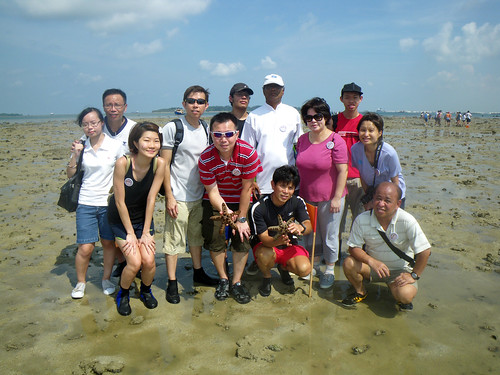
Nevertheless, I quickly got over it and was engaged in my guiding and also by their enthusiasm.

The first animal that we saw was the Mangrove Horseshoe Crab (Carcinoscorpius rotundicauda). This species is probably the most toxic species with the poison (called tetrodotoxin) concentrating in their eggs. Ironically, this is a delicacy in Thailand and many have suffered from the consequences from vomiting and numbness to death due to improper processing of the animal.

Sponges are immobile animals that can feed actively through pumping water containing nutrients through its porous body and filtering them using tiny hairs inside. However, this is one animal that we should not touch as many of them are coated with toxins. Even so, these chemicals are very important in medical research as they hold a lot of potential for anti-cancerous drugs. The one above is a brown sponge (Spheciospongia vagabunda).

This Dog Whelk (Nassarius sp.) is a scavenger and it moves about the sandy shore using its long siphon to sense its food. On its shell was a sea anemone piggy-backing on it, getting a free ride to carry the animal to, hopefully, greener pastures.

Next, this huge snail with the shell about 10cm long is called the Noble volute (Cymbiola nobilis). Sadly speaking, amateur collectors harvest them for their beautiful shells or sell them in the seafood industry since this is an edible species. So far, the ones at Semakau seems to be surviving well, with many sightings of them laying eggs like this one above.

Today was a nice day for seeing the Chocolate-chip stars (Protoreaster nodosus); we actually saw 6 of them in all! And this is also my first time seeing one with 6 arms too.

Even though today's tide was strangely high, the hunter seekers still managed to do a great job and found a seahorse (Hippocampus comes)! Seahorses are known to have a reverse role in child bearing, whereby the female actually lays her eggs into the pouch of their mate where it will be fertilise.

The fan worm (Sabellastarte indica) has feathery mouthparts that extend out of the water to filter nutrients in the water.

Another interesting find by the hunterseekers were these juvenile Cushion Stars (Culcita novaeguineae). They are so named as their adults are very much inflated looking a a pillow. Many seastars have variable colouration and this was my first time seeing a one with a pretty mosiac pattern (top left).
Amazingly, while editing my photos, it seemed I actually missed out this patterned cushion star even though I staring right at it! You can actually see it in my earlier photo on the right side of the fan worm.

Just before we left the reef flat, I spotted a tiny Flatworm (Pseudoceros sp.) crawling on the sand. Many species of flatworms are brightly coloured for a reason. Either they themselves possess a powerful nervous toxin or that they are mimicking another animal, normally a sea slug that is poisonous.

Another pleasant outing out in the sun, though I was very dehydrated by the end of the day.

No comments:
Post a Comment